Picture this: you’re cruising down an open road, feeling the breeze, absorbing vitamin D from the sun, and getting your heart rate up as you pedal. If the weather isn’t cooperative, you can hop on an exercise bike, pop on your headphones, or take a class. Whether it’s a leisurely bike ride to reduce stress or you’re training to increase endurance for a race, cycling is versatile.
Cycling regularly can benefit your cardiovascular health, mental health, aerobic capacity, muscular strength, and body composition. It’s adaptable for all fitness levels: it works for beginners or athletes who need low-impact cardio, and it’s a major sport with different types of races and even a place in the Olympics.
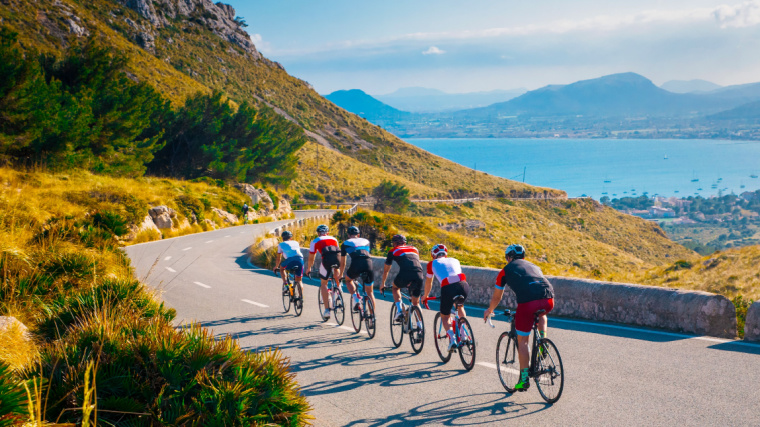
Whether you’re a cyclist training for a triathlon or a newbie wanting more info on this cardio workout — read on. We’ll outline all the benefits of cycling, tips to perform your best, differences in indoor versus outdoor cycling, and let you know how to get started. We’ll also address your number one question: does cycling build muscle? Strap on your helmet; here we go.
Editor’s Note: The content on BarBend is meant to be informative in nature, but it should not be taken as medical advice. When starting a new training regimen and/or diet, it is always a good idea to consult with a trusted medical professional. We are not a medical resource. The opinions and articles on this site are not intended for use as diagnosis, prevention, and/or treatment of health problems. They are not substitutes for consulting a qualified medical professional.
- Benefits of Cycling
- Cycling Tips
- Indoor Vs. Outdoor Cycling
- How to Start Cycling
- Does Cycling Build Muscle
- Frequently Asked Questions
Benefits of Cycling
Ready to hop on a stationary bike or hit the road? Here are all the ways that cycling can benefit your health and fitness: muscle mass and increased strength, cardio gains, mental health, and more.
May Help Induce Hypertrophy
If your goal is to build muscle mass, you’ll need to do resistance training and eat enough calories and protein. Cycling isn’t a major muscle-building activity, but some evidence shows it can help induce muscle hypertrophy.
Many people wonder if cycling builds muscle because professional cyclists have visibly large leg muscles — particularly calf muscles. Professional cyclists likely engage in resistance training in addition to cycling, and genetics may play a role. But cycling may contribute since they do such a high volume over time. (1)
A review of studies investigated these ideas. The review states that cycling training induces hypertrophy and strength gains in young and older adults. Older adults were able to increase their muscle quality more than younger adults. The review notes that it likely takes longer to build significant muscle with cycling than with resistance training. (1)
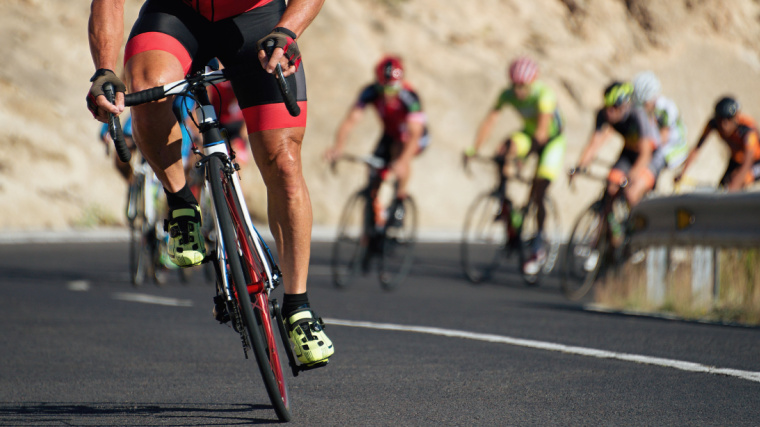
[Read More: The 12 Best Cross-Training Shoes]
If you cycle with high resistance, whether on a stationary bike with controls or while mountain biking, you are stressing your lower body muscles with tension. Over time, it makes sense that this may stimulate muscle growth.
Strengthens Lower Body
Cycling may build muscle to some degree, but it will likely make you stronger. It may not increase your strength as much as weight training, but a degree of strength training is involved.
Pedaling, especially with some resistance, works your glutes, hamstrings, quads, and calf muscles. The movement of pushing and pulling the pedals engages both sides of your legs. It’s lower body heavy, but if you take a cycling class, you may also work your upper body a bit.
[Read More: The Best Full-Body Bodybuilding Workout for Beginner to Advanced Lifters]
The review of studies on cycling’s impact on strength and hypertrophy found that older adults may gain more strength than younger adults. It notes that younger adults may need a higher volume of work to build significant strength and suggests doing high-intensity interval training (HIIT) with cycling. (1)
Boosts Cardiovascular Health
One of the main health benefits of cycling is that it can improve your cardiovascular health.
Cycling is aerobic exercise, which refers to any form of physical activity that increases your heart rate and breathing by utilizing large muscle groups that you perform rhythmically for some time. Some of the benefits of cardio are well-known: improving blood flow, regulating blood pressure and blood sugar, reducing cholesterol, and helping prevent heart diseases. (2)(3)
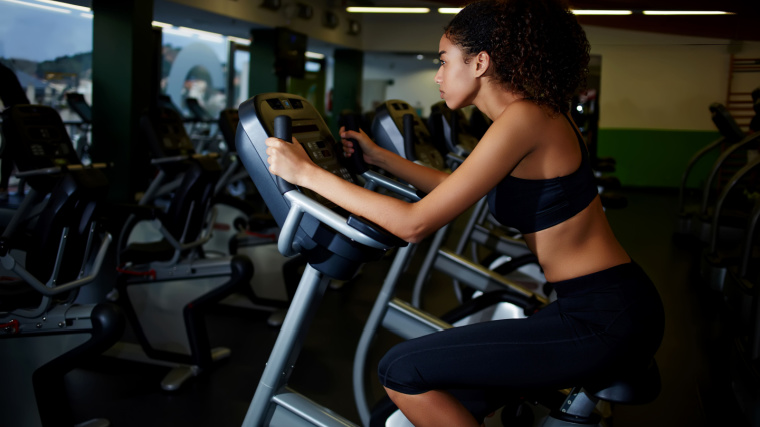
Any type of regular cardio exercise will get you these benefits, but there are specific studies on cycling as well. A 2019 review of studies shows that regular cycling was linked with a lower risk of cardiovascular diseases and mortality. (4)
Builds Endurance
In addition to your cardiovascular health, cycling is excellent for improving your endurance. Taking endurance rides at a lower intensity for a more extended period can increase how long you can work before you get fatigued.
Cycling can function as LISS cardio (low-intensity steady-state cardio) — a form of exercise that you do at a low intensity for a long time without resting. Some evidence shows that training well below your lactate threshold can improve your aerobic capacity. (5)
This activity builds endurance but also requires endurance. Competitive road cycling can last between 50 to 100 minutes. One study shows that three main factors influence your performance: your VO2 max, your lactate threshold, and your cycling economy (CE). CE refers to the oxygen cost compared to your power output. (6)
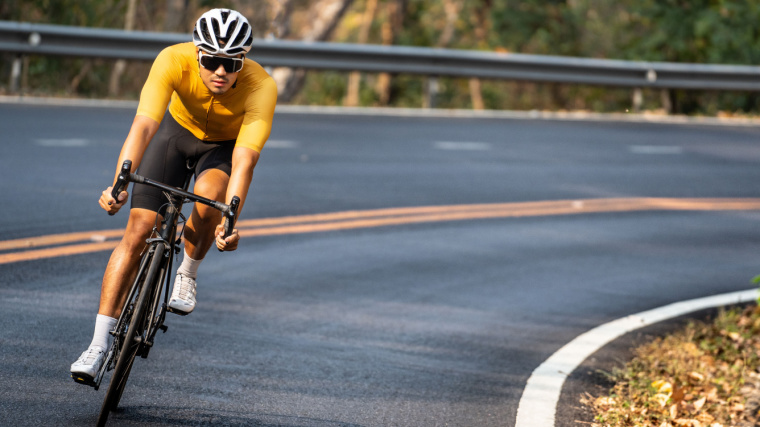
This study found that one of the best ways to improve your CE is to perform maximal strength training, heavy weights, and low reps, to increase strength, not muscle size. The study concludes that maximal strength training improved CE, work efficiency, and the time to exhaustion at maximum aerobic power in cycling. (6)
It stands to reason, then, that improving your CE through cycling may in turn have a positive impact on your stamina when lifting heavy weights. The more energy you have to power through those four sets of eight back squats, the stronger you stand to get.
Low-Impact Cardio
Cycling is low-impact cardio — your feet stay on the pedals the whole time. Low-impact exercise can benefit people with joint pain or conditions, people recovering from injuries, and strength athletes looking to give their joints and ligaments a break from intense training.
[Read More: The 15 Best Home Gym Machines]
Strength athletes can add cycling into their routine on an active recovery day. Cycling can help improve blood flow and may reduce inflammation between lifting sessions. You’ll get all the benefits of cardiovascular fitness improvement with none of the tough pounding on your joints that you might get from running on a treadmill.
May Improve Mental Health
Aerobic exercise, including cycling, has been shown to help reduce symptoms of anxiety and depression. It can improve your self-esteem and cognitive function, boost your mood, and help you cope with stress. Spending time outdoors in nature may also help to reduce stress. (7)(8)
An outdoor bike ride, mountain biking, or off-roading can all be healthy mood boosters.
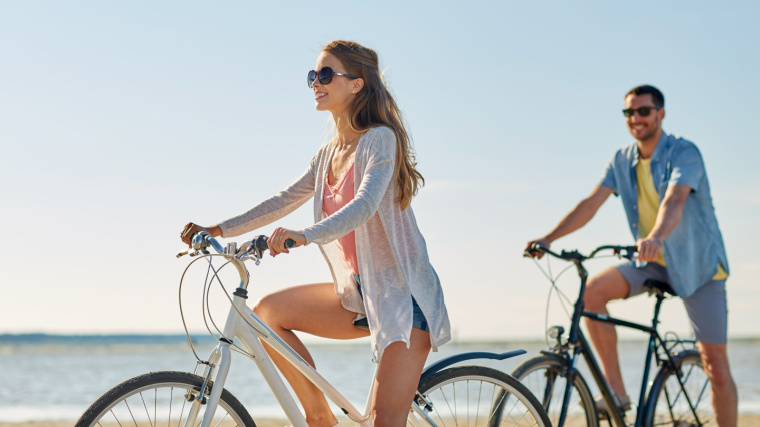
Some studies show that using cycling as a form of transportation can decrease symptoms of depression and increase feelings of happiness and well-being. (9)
A study on 100 older adults shows outdoor cycling can improve cognitive function, executive function, mental health, and well-being. (10)
Burns Calories
If you’re trying to lose body fat, it’s important to reduce your caloric intake while eating a healthy diet, resistance train to preserve your lean muscle, reduce stress, and sleep well. Cardio exercise like cycling can help boost your total daily energy expenditure (TDEE), so you can try to burn more energy (calories) than you’re taking in.
How long you cycle in a single session may determine how many calories you can burn, but the intensity also matters. Cycling at 50 to 65 percent of your maximum heart rate for 45 to 60 minutes as a LISS workout may cause your body to burn fat as an energy source. (5)
Great for High-Intensity Interval Training
Cycling is great and convenient for a HIIT (high-intensity interval training) workout. In HIIT, you alternate short bursts of high-intensity effort with short periods of active recovery or rest. You should be around 80 to 95 percent of your max heart rate for your bursts of effort and drop to 40 to 50 percent during your recovery.
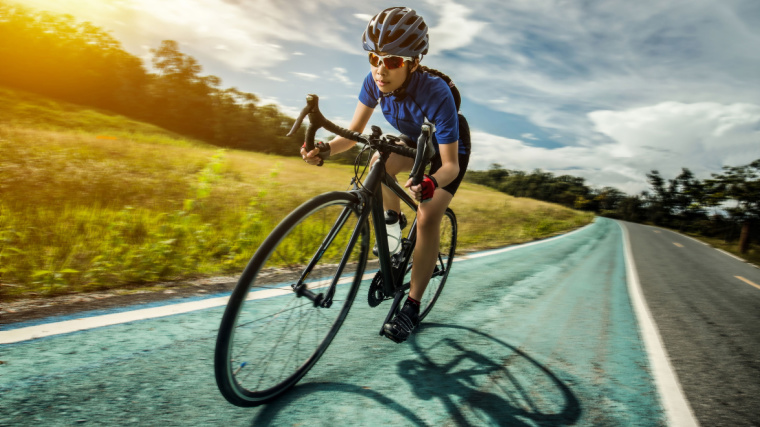
[Read More: The Best Online Workout Programs for Coaching, Cardio, Value, and More]
It may be more feasible to do cycling for HIIT while indoor cycling. For example, you can pedal as fast as possible as your “sprint” for 15 seconds, then do an easy ride for 60 seconds, and continue for several rounds.
Cycling Tips
Here are our top five tips for cycling. Keep these in mind whether you hit the road or the stationary bike.
Warm Up and Cool Down
All cycling workouts should start with a dynamic warm-up and end with a cool-down.
A complete dynamic warm-up generally includes light aerobic activity, dynamic stretching, and movement preparation. A dynamic stretch is a moving stretch; you may move throughout your range of motion instead of holding still at your end range. These are best before a workout to manage injury risk, improve performance, and prepare you for exercise. (11)
[Read More: The 5 Best Fitness Trackers]
Once you’re on the bike, do some more warming up by pedaling at a low intensity before you increase to where you want to be for your workout. After your workout, begin cooling down by pedaling at a lower intensity.
Finish with a quick cool-down stretch session. Static stretches, where you hold the position without moving, are best done after your workout. Static stretching may help increase your range of motion and ease stiffness. (11)
Use Safety Gear Outside
If you’re cycling outside, be sure that you use proper safety gear.
- Get a well-fitting helmet.
- Wear appropriate, well-fitting shoes.
- If you cycle at night, get a light for your bike and wear reflective clothing.
- In hot weather, wear sunglasses and sunscreen. In cold weather, wear warm, waterproof athletic clothing.
- If you cycle in a city, stay in the bike lane and follow the traffic rules.
Engage Your Muscles
Cycling is aerobic exercise, but engage your muscles while you ride.
- Actively push through your heels to engage your glutes when you move forward.
- Keep a firm but relaxed grip on your bike handles so you’re not overly squeezing and stressing your wrists.
- Different bikes call for various postures. When possible, keep your upper body upright and engage your core.
- If safe, stand up while you pedal to increase your intensity and difficulty.
- Most indoor and outdoor bikes allow you to increase your resistance, enabling you to work your leg muscles more.
Do Resistance Training, Too
It’s essential to supplement your cycling work with resistance training. Resistance training helps you build and maintain muscle and strength. It can help you prevent injury and improve your cycling performance.
Cycling is not a weight-bearing form of exercise, so it does not improve bone density like running on a treadmill can. Weight-bearing exercise refers to exercise where you support your body weight while you work out. Since your feet don’t leave the pedals and you’re sitting down, cycling doesn’t qualify. (12)
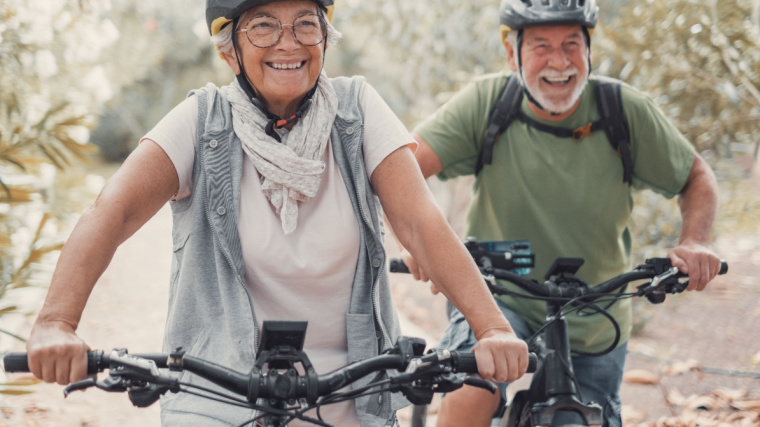
[Read More: Best Posture Correctors That Provide Posture Support]
Older adults, especially cis women, are prone to developing osteoporosis — a decrease in bone mass that can lead to fractures. Resistance training, nutrition, and weight-bearing cardio exercise can help prevent or manage osteoporosis. Older folks who enjoy cycling should supplement with resistance training to strengthen their bones. (12)
The previously cited study shows that maximal strength training can also improve your cycling endurance. The study recommends a 20-minute training session of four sets of four half-squats. Half-squats target your hip flexors and quadriceps and can help strengthen them for cycling. (6)
Indoor Vs. Outdoor Cycling
Both indoor and outdoor cycling can benefit your health and help you reach your fitness goals. Let’s break down some key factors of each type.
Indoor Cycling
- You can get your own stationary exercise bike or use one at the gym. You can customize your speed and resistance, follow a pre-set workout, or take a group cycling class.
- If the weather isn’t nice or you don’t live in a safe area, you can still get your workout done on an indoor bike.
- For busy parents with limited time to work out, getting your own bike allows you to squeeze in a ride in your free time.
- You can do indoor cycling to prepare for a race or event. You can control your speed and effort to mimic the conditions you want to aim for.
- Standing during indoor cycling is generally safe — making it a more intense workout that works your lower body and core from the comfort of home.
Outdoor Cycling
- Cycling outdoors can boost your mental health and expose you to vitamin D.
- With enough space, you can do different types of outdoor cycling, like long-distance cycling or mountain biking. You can vary your speed as the resistance will change naturally, riding over the ground.
- Outdoor cycling can involve different terrains. You ride over various types of ground in mountain biking and off-road cycling. Different terrains, including hills, increase resistance and difficulty and may work more muscle groups.
- Outdoor cycling, along with swimming and running, is part of a triathlon.
- You can use cycling as a form of commuting to work. Many cities have bike-share options if you don’t have your own bike. Active commuting with cycling may help reduce the risk of cardiovascular diseases. (13)
How to Start Cycling
Cycling is generally accessible for beginners. Here are the best ways to start (after your warm-up).
Try a Class
If you’d like to do indoor cycling, signing up for a group class can be a great way to start. Being in a group environment can be motivating. The instructor should be guiding everyone to use proper form. You can also show up before class to ask questions and determine the correct seat height.
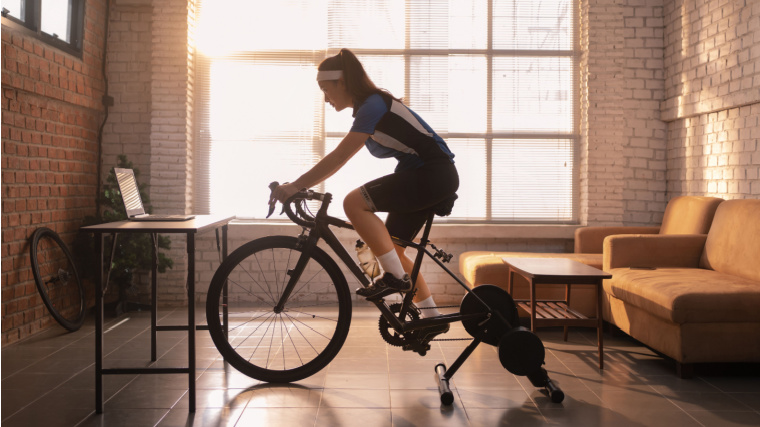
[Read More: 5 At-Home Workouts for Strength, Muscle Growth, Power, and More]
If group classes aren’t for you, you can hop on a bike at the gym and choose a pre-set workout. Or, look up a cycling workout on YouTube, play it on your phone, and follow along.
Take a Bike Ride
If you’d like to get into outdoor cycling, start by taking a short bike ride in a safe area. “It’s just like riding a bike” is a saying for a reason — if you learned to ride a bike as a kid, your body probably remembers.
If you never learned how to ride a bike as a kid, it’s not too late. Finding an instructor or personal trainer to guide you can be helpful. Taking a few personalized lessons will set you up for safe riding.
Does Cycling Build Muscle?
If you want to grow your glutes and legs, you need to do back squats, deadlifts, and lunges — and eat. Professional cyclists with large leg muscles likely do resistance training in addition to cycling.
However, cycling may build some muscle for certain populations. Older adults and sedentary people may be more likely to build some muscle with cycling. (1)
A review of studies examined whether aerobic exercise can induce skeletal muscle growth. The review states that the evidence they found shows that aerobic exercise can cause hypertrophy. They saw an increase in muscle size after aerobic training in sedentary people and aging people experiencing muscle loss. (14)
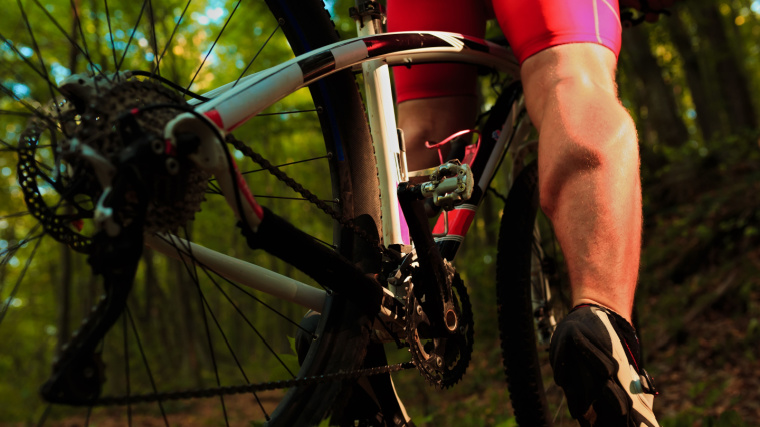
[Read More: What Are Workout Splits and Which Is the Best One?]
The review notes that to build muscle with aerobic exercises, there needs to be a large number of muscular contractions that cause a high-volume, low-load stress on the muscle to be comparable to a resistance training program. (14)
The review states these factors are necessary:
- Exercise Intensity: 70 to 80 percent heart rate reserve
- Duration: 30 to 45 minutes
- Frequency: 4 to 5 days per week. (14)
This review of studies is not specifically on cycling but on aerobic exercise in general.
Cycling Up
Indoor and outdoor cycling can majorly benefit your physical and mental health. It improves cardiovascular health and fitness, increases endurance, and strengthens your lower body. Cycling works for a HIIT or a LISS workout and helps you burn calories to increase your TDEE.
Indoor cycling is great for a rainy or busy day, and you can up your resistance for a more intense workout. So hop onto a stationary bike near you to let off some steam and feel like a kid again on your next active recovery day.
FAQs
Got some lingering questions on cycling?
Older people and sedentary people may gain some muscle from cycling. Cycling, in addition to resistance training and eating enough calories and protein, can help you gain muscle.
Cycling requires a very high volume, combined with sufficient intensity, to stimulate significant muscle growth in active adults. They likely won’t get bigger if you are not cycling at the volume of a professional cyclist in addition to maximal resistance training.
Cycling works well on an active recovery day when you’re following a resistance training plan to build muscle. It can improve blood flow and may reduce inflammation. These factors can help contribute to muscle growth over time, as they can improve the overall quality of your training program.
References
- Ozaki H, Loenneke JP, Thiebaud RS, Abe T. Cycle training induces muscle hypertrophy and strength gain: strategies and mechanisms. Acta Physiol Hung. 2015 Mar;102(1):1-22.
- Patel H, Alkhawam H, Madanieh R, Shah N, Kosmas CE, Vittorio TJ. Aerobic vs anaerobic exercise training effects on the cardiovascular system. World J Cardiol. 2017 Feb 26;9(2):134-138.
- Nystoriak MA, Bhatnagar A. Cardiovascular Effects and Benefits of Exercise. Front Cardiovasc Med. 2018 Sep 28;5:135.
- Nordengen S, Andersen LB, Solbraa AK, Riiser A. Cycling is associated with a lower incidence of cardiovascular diseases and death: Part 1 – systematic review of cohort studies with meta-analysis. Br J Sports Med. 2019 Jul;53(14):870-878.
- American Council on Exercise. HIIT vs. Steady State Cardio: Which One is Best for Your Clients? ACE Fitness.
- Sunde, Arnstein1; Støren, Øyvind1,2; Bjerkaas, Marius1; Larsen, Morten H1; Hoff, Jan2,3; Helgerud, Jan2,4. Maximal Strength Training Improves Cycling Economy in Competitive Cyclists. Journal of Strength and Conditioning Research 24(8):p 2157-2165, August 2010. |
- Sharma A, Madaan V, Petty FD. Exercise for mental health. Prim Care Companion J Clin Psychiatry. 2006;8(2):106.
- Kondo MC, Jacoby SF, South EC. Does spending time outdoors reduce stress? A review of real-time stress response to outdoor environments. Health Place. 2018 May;51:136-150.
- Green S, Sakuls P, Levitt S. Cycling for health: Improving health and mitigating the climate crisis. Can Fam Physician. 2021 Oct;67(10):739-742.
- Leyland LA, Spencer B, Beale N, Jones T, van Reekum CM. The effect of cycling on cognitive function and well-being in older adults. PLoS One. 2019 Feb 20;14(2):e0211779.
- Behm DG, Chaouachi A. A review of the acute effects of static and dynamic stretching on performance. Eur J Appl Physiol. 2011 Nov;111(11):2633-51.
- Hong AR, Kim SW. Effects of Resistance Exercise on Bone Health. Endocrinol Metab (Seoul). 2018 Dec;33(4):435-444.
- Celis-Morales C A, Lyall D M, Welsh P, Anderson J, Steell L, Guo Y et al. Association between active commuting and incident cardiovascular disease, cancer, and mortality: prospective cohort study BMJ 2017
- Konopka AR, Harber MP. Skeletal muscle hypertrophy after aerobic exercise training. Exerc Sport Sci Rev. 2014 Apr;42(2):53-61.
Featured Image: kovop / Shutterstock
The post 8 Benefits of Cycling to Fuel Your Next Ride appeared first on BarBend.
